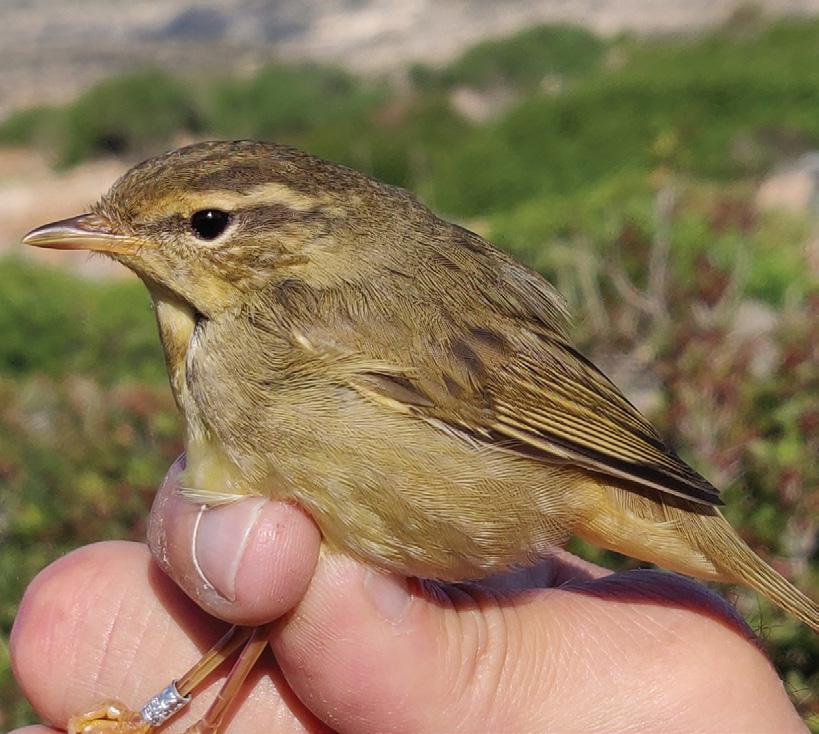
3 minute read
Over 23,000 birds ringed in a year
A very busy year for the BirdLife Malta Ringing Scheme
The BirdLife Malta Ringing Scheme was active throughout 2020 with ringing sessions carried out every month with intensity increasing during passage periods in spring and autumn targeting migrant species. Breeding species and wintering species were also monitored through ringing.
Advertisement
The total number of birds ringed in 2020 was 23,733. This is very much higher than average and this was partly because some ringers had more free time due to the COVID-19 situation. This was also aided by a very good spring migration of passerines.
A slightly higher than average number of wintering birds were ringed in 2020 with 1,153 birds ringed in January and February. A total of 9,202 birds were ringed between March, April and May, of which 6,573 were ringed in April. The most common spring migrants were Wood Warbler (1,671 birds), Common Whitethroat (1,109 birds) and Garden Warbler (890 birds), all ringed from March to May. Spring 2020 was an exceptional year for the black and white flycatchers, with a total of 583 Pied Flycatcher, 290 Collared Flycatcher and one Semi-Collared Flycatcher ringed.
In the summer months, efforts were directed towards breeding birds and early autumn migrants such as waders. A good number of Common Swift and Pallid Swift were also ringed with some interesting insight on the breeding behaviour of these birds that recently started colonizing our islands. Seabird studies continued in the final year of the LIFE Arċipelagu Garnija project, which apart from ringing of all four breeding species (Yelkouan Shearwater, Scopoli’s Shearwater, Mediterranean Storm-petrel, Yellowlegged Gull), also included tagging with GPS loggers and geo-locators. This will enable us to study both foraging trips and also wintering areas of such birds.
Autumn migration continued where spring left off with good numbers of both Trans-Saharan migrants (birds that winter south of the Sahara Desert) and non-Trans-Saharan ones (birds that winter north of the Sahara Desert and in the Mediterranean) ringed. From September to November, a total of 10,772 birds were ringed, with Common Chiffchaff (2,657) and Robin (2,968) together accounting for more than half this amount.
Rare birds ringed in 2020 included two Olive-backed Pipit, one Rufous-tailed Scrub Robin, two Moussier’s Redstart, one Savi’s Warbler, one Dartford Warbler, one Moltoni’s Warbler, one Eastern Olivaceous Warbler, two Western Olivaceous Warbler and one Radde’s Warbler. Constant effort ringing continues from previous years in the BirdLife Malta-managed reserves of Għadira and Simar. In total, over 7,000 birds were ringed in 2020 at these two reserves. Regular sessions were also held in other sites including Salina Nature Reserve, Buskett and Kemmuna. In Kemmuna, migration monitoring ringing projects were held successfully with ongoing standardized ringing done in April-May 2020 and in October-November 2020 with around 4,500 birds ringed.
Various interesting local recaptures were made in 2020. Interesting longevity records included a 20 year-11-month-old Scopoli’s Shearwater, a 19-yearold storm-petrel, an 18-year-old Yellow-legged Gull, a 13-yearold Yelkouan Shearwater, an 8-year-old Little Ringed Plover, two almost-8-year-old Spanish Sparrows, a 7-year-old Sardinian Warbler, a 7-year-old Common Chiffchaff and two 5 year-old Blackcaps. A number of foreign ring controls from various EURING partners were processed by BirdLife Malta. Some were colour-ringed birds that were observed or photographed whilst others were also injured birds collected for rehabilitation.
The BirdLife Malta Ringing Scheme also satellite-tagged three European Turtle Doves in May 2020 on Kemmuna as part of its ongoing study to better understand how this vulnerable species can be protected. An attempt was also made to satellite-tag a rehabilitated Honey-buzzard in October, however the bird was lost within a few hours of release, possibly due to illegal hunting.
Radde’s Warbler (Phylloscopus schwarzi) – this rare bird was ringed on Kemmuna on 20 October. This is only the 4th record of this species in the Maltese Islands, all records are of ringed birds with the most recent one prior to this in 2007. This bird breeds in Siberia and migrates to southeast Asia where it spends the winter. It can be identified from similar looking warblers by its dark, olivetoned colour, heavy bill, long supercilium and bright, thick legs. WORDS Nicholas Galea Head of the BirdLife Malta Ringing Scheme








